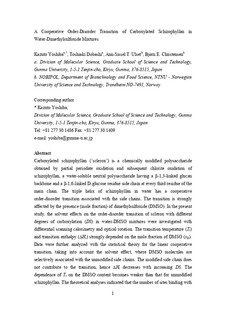Cooperative Order−Disorder Transition of Carboxylated Schizophyllan in Water−Dimethylsulfoxide Mixtures
Journal article, Peer reviewed
Accepted version

Åpne
Permanent lenke
http://hdl.handle.net/11250/2592762Utgivelsesdato
2018Metadata
Vis full innførselSamlinger
Originalversjon
Journal of Physical Chemistry B. 2018, 122 (25), 6551-6558. 10.1021/acs.jpcb.8b02982Sammendrag
Carboxylated schizophyllan (“sclerox”) is a chemically modified polysaccharide obtained by partial periodate oxidation and subsequent chlorite oxidation of schizophyllan, a water-soluble neutral polysaccharide having a β-1,3-linked glucan backbone and a β-1,6-linked d-glucose residue side chain at every third residue of the main chain. The triple helix of schizophyllan in water has a cooperative order–disorder transition associated with the side chains. The transition is strongly affected by the presence (mole fraction) of dimethylsulfoxide (DMSO). In the present study, the solvent effects on the order–disorder transition of sclerox with different degrees of carboxylation (DS) in water–DMSO mixtures were investigated with differential scanning calorimetry and optical rotation. The transition temperature (Tr) and transition enthalpy (ΔHr) strongly depended on the mole fraction of DMSO (xD). Data were further analyzed with the statistical theory for the linear cooperative transition, taking into account the solvent effect, where DMSO molecules are selectively associated with the unmodified side chains. The modified side chain does not contribute to the transition; hence, ΔHr decreases with increasing DS. The dependence of Tr on the DMSO content becomes weaker than that for unmodified schizophyllan. The theoretical analyses indicated that the number of sites binding with the DMSO molecule and the successive ordered sequence of the ordered unit of the triple helix are changed by carboxylation.